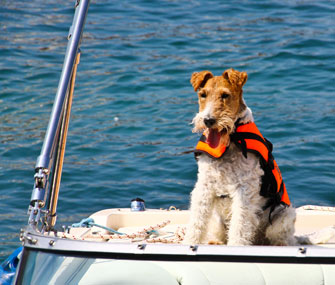Boating Basics: Tips to Keep Your Dog Safe
Published on May 06, 2015
Skip To

There are dogs who are more inclined to love the water. In addition to the above breeds, dogs who are especially likely to take to boating include Airedales, American Water Spaniels, Chesapeake Bay Retrievers, Irish Water Spaniels, Keeshonden, Newfoundlands, Nova Scotia Duck Tolling Retrievers, Otterhounds, Poodles and Schipperkes. And there are breeds who really should stay on the beach or dock, like Pugs, Bulldogs and other barrel-chested, short-nosed, top-heavy breeds.
No matter what the breed, though, the most important trait is adaptability. Your dog should be okay with confined quarters, especially if you’re planning a long-distance voyage. Highly active dogs may demand regular opportunities to swim or may respond well to learning chores, such as bringing you a line or acting as lookout for dolphins or other boaters.
Whether your craft is a kayak or a yacht, your dog can be the perfect boating companion. But before you cast off, make sure your furry first mate is a seaworthy companion. Here are some simple tips to help ensure that your pooch is as comfortable on water as on land.
Ship Shape and Ready to Sail
Choose the right boat. Your dog should
have enough space to move around, and the gunwale (the railing along the side of
the boat) should be high enough to keep him securely on board. A canoe, kayak
or rowboat is best for small dogs or well-behaved larger dogs.Practice on dry land. For a small craft, such as a kayak or canoe, accustom your dog to getting in and out of it on dry land first. Let him jump in, and then have him sit and stay until you release him. Then practice in shallow water until he seems comfortable. Go for a few short paddles before you try longer distances.
Get him used to the boat. For a powerboat or sailboat, let your dog explore the boat and get used to the rocking motion while still at the dock. Some dogs may balk at crossing a gangplank or jumping from dock to boat, but letting an experienced dog lead the way or luring with a treat can help.
Brush up on important commands. On any boat, dogs should know and respond to the commands “sit” and “stay.” These can be essential if you run into waves or rapids, especially in a small craft, such as a kayak.
Secure your safety line. Prevent a dog-overboard situation with a safety line. Run a jack line along the port and starboard sides of your boat and connect it by a ring to safety lines that attach to your dog’s harness. This will keep him secured while allowing him to move freely about the boat. For added safety, put up netting between the stanchions all the way around the boat.
Put on a life vest. If he does go in the drink, a canine life vest will help keep your dog afloat until you can reel him in. Choose one in a highly visible color, such as yellow or orange. It should fit snugly but comfortably without restricting his movement and have a loop or handle on top, so you can grab it easily with your hand or a boat hook. Practice pulling him out before you actually have to do so. It might be necessary to have someone in the water giving him a boost, while someone else on the boat helps to hoist him up.
Don’t forget his collar! Be sure your dog always wears a collar and tag bearing your name, the name of your boat and the slip number. A registered microchip provides additional insurance that he can be identified and returned to you if he gets lost.
Be sun smart. Apply pet-safe sunscreen to prevent sunburn, especially if your dog has light-colored fur or little hair. His nose and ears are especially at risk. Make sure he has a shady spot available in the heat of the day. Dog goggles can help protect his eyes on bright, sunny days.
Be prepared to hoist him back into the boat. At some point, your dog — especially if he’s a Retriever — will probably jump out of the boat to go for a swim or pursue a duck. As long as he knows how to swim and the current isn’t swift, let him enjoy. Again, practice getting him back on board both on dry land and in shallow water. You can lift a small dog up by the handle of his life vest, but a larger dog may need to practice scrambling back in, climbing a ladder or letting you help him.
Plan a post-sail bath. Salt water can dry your dog’s fur, and lake water can be contaminated with algae. Give him a freshwater rinse after any planned or unplanned dunkings.
Pack seasickness medications. Yes, dogs can suffer from motion sickness. Ask your veterinarian if he recommends any medication for your dog in case you need to administer it.
Most important, have fun!
More on Vetstreet:





